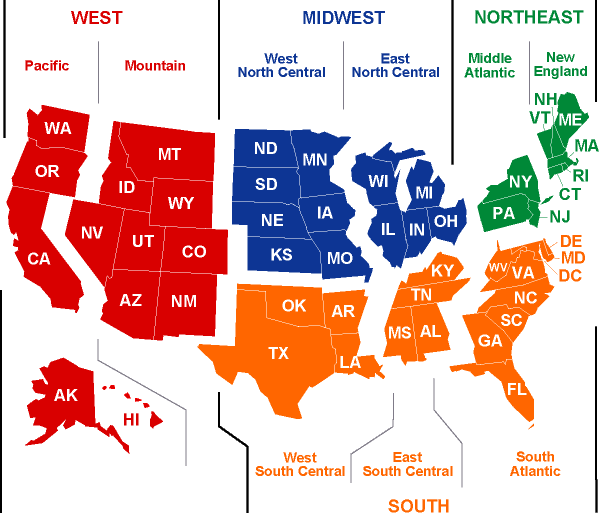Current Market Conditions
These charts, maps and indicators represent the most currently available Technical Analysis ( "TA") of National, State and Local Real Estate Markets.
TA is visual, relying on Supply and Demand charts because these charts also track the most important and most elusive driver of future price trends: Market Psychology.
TA has become the dominant methodology for predicting stock, bond, commodity and currency market cycles worldwide and is used by ALL major investment banks and international trading desks as the underlying basis for TRILLIONS of dollars in DAILY investment transactions.
STAR Indicators

The STAR momentum indicators show the 'energy' behind any market. For a sustained up-cycle, it MUST be supported by momentum. Market Psychology influences momentum but is not the only driver.
The first step in locating investment candidates is evaluating the STAR indicators. Each of the six 'triggers' represent a distinct Technical Analysis (TA) 'event.'
The left-most columns are Short-Term triggers and carry far less significance than the Long-Term indicators on the right.
However, all Trend Reversals (up or down) BEGIN with the short term triggers. They provide early-warning signals, especially when they develop a consistent pattern of changing colors (from green to red, or red to green) 'growing' from left to right.
Green means positive, upward sloping momentum. Red means the opposite. Yellow occurs when, in the current period, the slope/direction changed for that trigger.
Markets that do not display a consistent color pattern; with seemingly random horizontal color changes from one period to the next, especially in the long-term triggers, are generally lacking ANY momentum, and are poor investment markets for Leveraged Appreciation.
STAR Momentum Indicators
Market Momentum (STAR) Indicators
Your State: USA
The STAR momentum indicators show the ‘energy’ behind any market. For a sustained up-cycle, it MUST be supported by momentum. Market Psychology influences momentum but is not the only driver.
The first step in locating investment candidates is evaluating the STAR indicators. Each of the six ‘triggers’ represent a distinct Technical Analysis (TA) ‘event.’
The left-most columns are Short-Term triggers and carry far less significance than the Long-Term indicators on the right.
However, all Trend Reversals (up or down) BEGIN with the short term triggers. They provide early-warning signals, especially when they develop a consistent pattern of changing colors (from green to red, or red to green) ‘growing’ from left to right.
Green means positive, upward sloping momentum. Red means the opposite. Yellow occurs when, in the current period, the slope/direction changed for that trigger.
Markets that do not display a consistent color pattern; with seemingly random horizontal color changes from one period to the next, especially in the long-term triggers, are generally lacking ANY momentum, and are poor investment markets for Leveraged Appreciation.
If you want to know more about HosuingAlerts just click here to learn more.

 Close Tab
Close Tab 

| Short-Term | Mid-Term | Long-Term | ||||
| #1 | #2 | #3 | #4 | #5 | #6 | |
| Current Qtr |  |
 |
 |
 |
 |
 |
| Prior Qtr |  |
 |
 |
 |
 |
 |
| 2 Qtrs ago |  |
 |
 |
 |
 |
 |
| 3 Qtrs ago |  |
 |
 |
 |
 |
 |
| Year ago |  |
 |
 |
 |
 |
 |
Six Trigger Alert Report
Market Momentum (STAR) Indicators
USA Overall
| Short-Term | Mid-Term | Long-Term | ||||
| #1 | #2 | #3 | #4 | #5 | #6 | |
| Current Qtr | ||||||
| Prior Qtr | ||||||
| Two Qtrs ago | ||||||
| Three Qtrs ago | ||||||
| Year ago | ||||||
| 2023/1 | ||||||
| 2022/4 | ||||||
| 2022/3 | ||||||
| 2022/2 | ||||||
| 2022/1 | ||||||
| 2021/4 | ||||||
| 2021/3 | ||||||
| 2021/2 | ||||||
| 2021/1 | ||||||
| 2020/4 | ||||||
| 2020/3 | ||||||
| 2020/2 | ||||||
| 2020/1 | ||||||
| 2019/4 | ||||||
| 2019/3 | ||||||
| 2019/2 | ||||||
| 2019/1 | ||||||
| 2018/4 | ||||||
| 2018/3 | ||||||
| 2018/2 | ||||||
| 2018/1 | ||||||
| 2017/4 | ||||||
| 2017/3 | ||||||
| 2017/2 | ||||||
| 2017/1 | ||||||
| 2016/4 | ||||||
| 2016/3 | ||||||
| 2016/2 | ||||||
| 2016/1 | ||||||
| 2015/4 | ||||||
| 2015/3 | ||||||
| 2015/2 | ||||||
| 2015/1 | ||||||
| 2014/4 | ||||||
| 2014/3 | ||||||
| 2014/2 | ||||||
| 2014/1 | ||||||
| 2013/4 | ||||||
| 2013/3 | ||||||
| 2013/2 | ||||||
| 2013/1 | ||||||
| 2012/4 | ||||||
| 2012/3 | ||||||
| 2012/2 | ||||||
| 2012/1 | ||||||
| 2011/4 | ||||||
| 2011/3 | ||||||
| 2011/2 | ||||||
| 2011/1 | ||||||
| 2010/4 | ||||||
| 2010/3 | ||||||
| 2010/2 | ||||||
TAPS Indicators

The TAPS (Technical Analysis Point Score) indicator is an easy to understand, graphical way to show the results of complex Technical Analysis (TA) 'Studies.'
The simple 'slider ball' can move a total of five notches starting from far left (Weak) to far right (Strong).
If the ball position has moved since the prior period, it will have a series of arrows behind it. If the arrows are on the left, that signifies a move from the left, from a weaker to a stronger position, and vice-versa.
Each detailed TA Study has its own slider ball indicator and consists of dozens to hundreds of individual calculations (collectively referred to as 'algorithms').
These detailed algorithms are aggregated and weighted to produce higher level Summary slider indicators until the top-level, overall score is attained.
Technical Analysis Point Score
(TAPS) Indicators
USA: USA
This is the Technical Analysis Point Score ranking for ONLY that particular city. It ignores any impact State, Regional or National market TAPS scores may have on that local market.
If you want to know more about HosuingAlerts just click here to learn more.

 Close Tab
Close Tab 

Real Estate Cycle Charts

Charts showing the annual appreciation or decline in real estate values over time are visual snapshots of Supply and Demand forces in action. Technical Analysis (TA) relies on these charts because they accurately reflect what ACTUALLY happened.
The practice of TA consists of what are called "Studies" – different sets of calculations and algorithms proven over time. These Studies include Market Psychology, the most powerful driver of all.
Because real estate is so cyclical (compared to the Stock Market, for example), relatively simple Studies can be used to accurately track local markets.
Long Term Real Estate Cycles
Your State: USA
Charts showing the annual appreciation or decline in real estate values over time are visual snapshots of Supply and Demand forces in action. Technical Analysis (TA) relies on these charts because they accurately reflect what ACTUALLY happened.
The practice of TA consists of what are called “Studies” – different sets of calculations and algorithms proven over time. These Studies include Market Psychology, the most powerful driver of all.
If you want to know more about HosuingAlerts just click here to learn more.

 Close Tab
Close Tab 


 Close Tab
Close Tab 

Matching your investing tactics and strategies to your local real estate market trends produces more deals with less risk, effort, and capital. Your micro market intelligence finds and targets those needle-in-a-haystack opportunities and dramatically increases your ROI while slashing your upfront acquisition and marketing costs. Learn more...

 Help
Help 

Current Market Conditions
These charts, maps and indicators represent the most currently available Technical Analysis ( "TA") of National, State and Local Real Estate Markets.
TA is visual, relying on Supply and Demand charts because these charts also track the most important and most elusive driver of future price trends: Market Psychology.
TA has become the dominant methodology for predicting stock, bond, commodity and currency market cycles worldwide and is used by ALL major investment banks and international trading desks as the underlying basis for TRILLIONS of dollars in DAILY investment transactions.
Master Score (raw)
This is the best single indicator (if you only want to look at ONE indicator). The “Master Score” is a proprietary algorithm that integrates our data into both a 'raw' score or a 'percentile ranking.'
The 'raw' score indicates the 'absolute' market strength (or weakness) compared to previous local and national real estate cycles.
Master Score (pct)
This is the best single indicator (if you only want to look at ONE indicator). The “Master Score” is a proprietary algorithm that integrates our data into both a 'raw' score or a 'percentile ranking.'
The indicator represents the Percentile Ranking when compared to ALL markets nationwide.
(TAPS) Technical Analysis (raw)
This is the Technical Analysis Point Score ranking after combining the Local (city-level) market with the State, Regional and National TAPS scores.
Higher Scores (towards RED colors) indicate positive, stronger market momentum.
The 'raw' score indicates the 'absolute' market strength (or weakness) compared to previous local and national real estate cycles.


(TAPS) Technical Analysis (pct)
This is the Technical Analysis Point Score ranking after combining the Local (city-level) market with the State, Regional and National TAPS scores.
Higher Scores (towards RED colors) indicate positive, stronger market momentum.
The indicator represents the Percentile Ranking when compared to ALL markets nationwide.


(STAR) Market Momentum (raw)
The STAR momentum indicators show the 'energy' behind any market. For a sustained up-cycle, it MUST be supported by momentum. Market Psychology influences momentum but is not the only driver.
Higher Scores (towards RED colors) indicate positive market momentum.
The 'raw' score indicates the 'absolute' market strength (or weakness) compared to previous local and national real estate cycles.


(STAR) Market Momentum (pct)
The STAR momentum indicators show the 'energy' behind any market. For a sustained up-cycle, it MUST be supported by momentum. Market Psychology influences momentum but is not the only driver.
Higher Scores (towards RED colors) indicate positive market momentum.
The indicator represents the Percentile Ranking when compared to ALL markets nationwide.


Annual HPA (Home Price Appreciation) (%)
Appreciation is the increase in a home's value over time. A home's appreciation is calculated based on the fair market value of comparable homes for sale in the neighborhood.
Higher Scores (towards RED colors) indicate positive market momentum.
The indicator represents the Percentile Ranking when compared to ALL markets nationwide.

Annual HPA (%) - 2 yr. CAGR
Appreciation is the increase in a home's value over time. A home's appreciation is calculated based on the fair market value of comparable homes for sale in the neighborhood.
The CAGR should 'smooth out" some of the wild swings in data – giving you a better indication of the true RELATIVE performance of the micro market.
Higher Scores (towards RED colors) indicate positive market momentum.
The indicator represents the Percentile Ranking when compared to ALL markets nationwide.

Annual HPA (%) - 3 yr. CAGR
Appreciation is the increase in a home's value over time. A home's appreciation is calculated based on the fair market value of comparable homes for sale in the neighborhood.
The CAGR should 'smooth out" some of the wild swings in data – giving you a better indication of the true RELATIVE performance of the micro market.
Higher Scores (towards RED colors) indicate positive market momentum.
The indicator represents the Percentile Ranking when compared to ALL markets nationwide.

Inflation Adjusted Annual HPA (%)
Appreciation is the increase in a home's value over time. A home's appreciation is calculated based on the fair market value of comparable homes for sale in the neighborhood.
Higher Scores (towards RED colors) indicate positive market momentum.
The indicator represents the Percentile Ranking when compared to ALL markets nationwide.

Quarterly HPA (annualized %)
This is the change in home prices from 3 months earlier and then annualized (i.e. – multiplied four) to get an annual equivalent appreciation rate.
Quarterly comparisons have more 'noise' in them, and will tend to bounce around a lot more than annual comparisons. However, quarterly data can also spot market reversals and changes quicker because it only looks back 3 months, instead of a year.
Higher Scores (towards RED colors) indicate positive, stronger market momentum.
The indicator represents the Percentile Ranking when compared to ALL markets nationwide.

Median Home Value (raw)
This is the estimated median house value of all Single Family Residential (SFR) properties in that market. The background color indicates it's ranking compared to all such markets on a percentile basis nationwide. Dark green is the 'highest' ranking, dark red is the lowest.
Higher Scores (towards RED colors) indicate positive, stronger market momentum.
The 'raw' score indicates the 'absolute' market strength (or weakness) compared to previous local and national real estate cycles.

Median Home Value (pct)
This is the estimated median house value of all Single Family Residential (SFR) properties in that market. The background color indicates it's ranking compared to all such markets on a percentile basis nationwide. Dark green is the 'highest' ranking, dark red is the lowest.
Higher Scores (towards RED colors) indicate positive, stronger market momentum.
The indicator represents the Percentile Ranking when compared to ALL markets nationwide.

Annual Rent Growth - 3yr CAGR (raw)
The annual percentage increase or decrease for the median rent charged for the median single family home over different time periods.
The CAGR should 'smooth out" some of the wild swings in data – giving you a better indication of the true RELATIVE performance of the micro market.
Higher Scores (towards RED colors) indicate positive, stronger market momentum.
The 'raw' score indicates the 'absolute' market strength (or weakness) compared to previous local and national real estate cycles.

Annual Rent Growth - 3yr CAGR (pct)
The annual percentage increase or decrease for the median rent charged for the median single family home over different time periods.
The CAGR should 'smooth out" some of the wild swings in data – giving you a better indication of the true RELATIVE performance of the micro market.
Higher Scores (towards RED colors) indicate positive, stronger market momentum.
The indicator represents the Percentile Ranking when compared to ALL markets nationwide.

Hot Market + Cash Flow (percentile)
This indicator combines a micro-market's cash flow potential AND its potential for appreciation.
The Cash Flow Ranking score is determined by dividing this zip code's median rent by its median home value, then ranking that score relative to all other zip codes nationwide.
The Hot Market Score RANK uses proprietary algorithms to score and rank each market relative to all other markets nationwide.
Higher Scores (towards RED colors) indicate positive market momentum.

Gross Rent Ratio (raw)
A high score means SFR rent rates have been increasing more in this market, RELATIVE to all markets nationwide.
Higher Scores (towards RED colors) indicate positive market momentum.
The 'raw' score indicates the 'absolute' market strength (or weakness) compared to previous local and national real estate cycles.

Gross Rent Ratio (pct)
A high score means SFR rent rates have been increasing more in this market, RELATIVE to all markets nationwide.
Higher Scores (towards RED colors) indicate positive market momentum.
The indicator represents the Percentile Ranking when compared to ALL markets nationwide.



 Close Tab
Close Tab 

Matching your investing tactics and strategies to your local real estate market trends produces more deals with less risk, effort, and capital. Your micro market intelligence finds and targets those needle-in-a-haystack opportunities and dramatically increases your ROI while slashing your upfront acquisition and marketing costs. Learn more...

 Help
Help 

U.S. Real Estate Cycles 1990 – 2024

U.S. Real Estate Cycles 1990 – 2024

#1 Amazon Bestseller

Feedback
Thanks. I have watched this twice to fully retain for better/future investing. Wish I had read this back in 2008 when I lost many hundred thousands.



